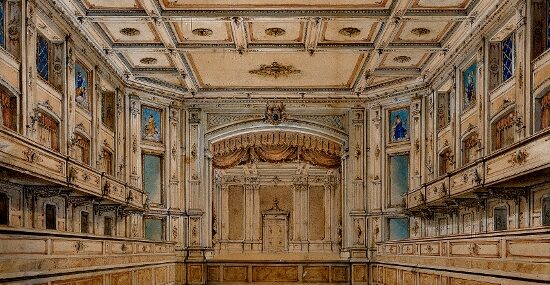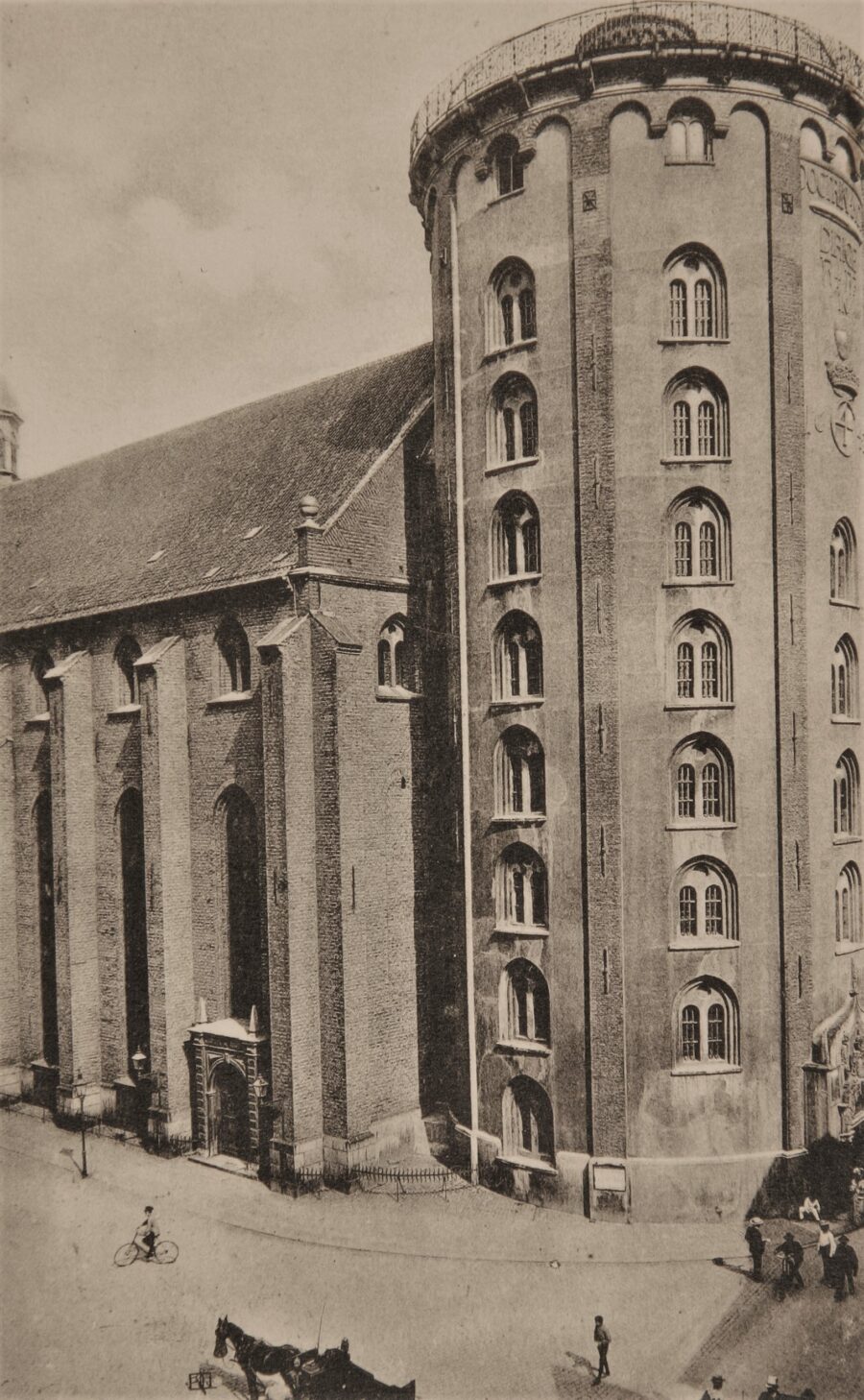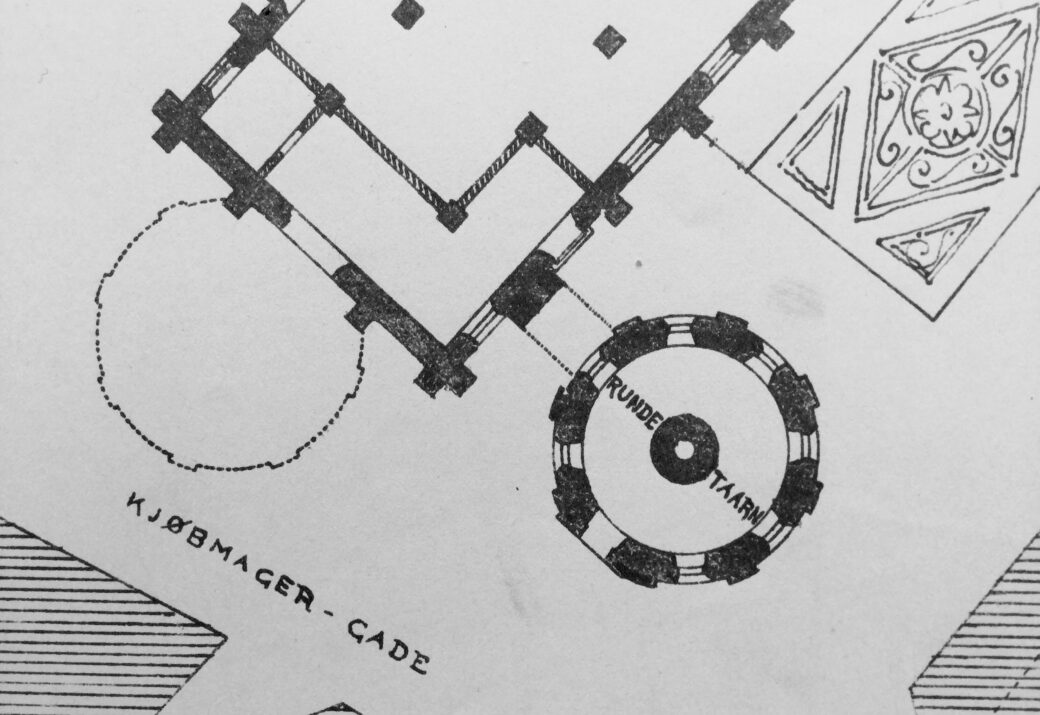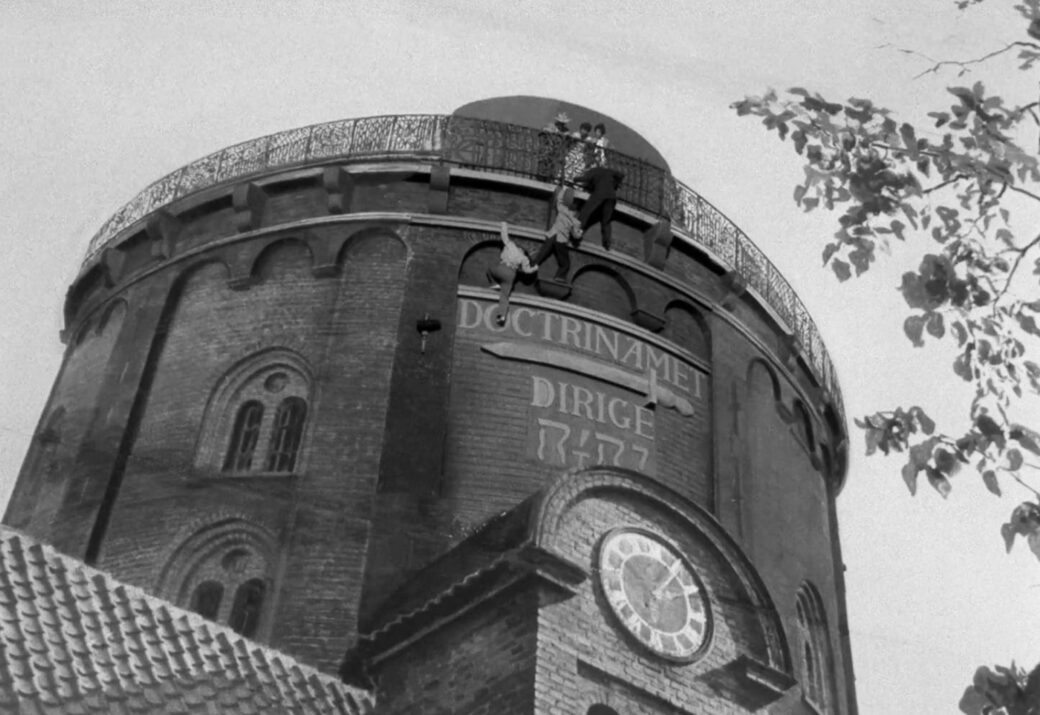This website uses cookies so that we can provide you with the best user experience possible. Cookie information is stored in your browser and performs functions such as recognising you when you return to our website and helping our team to understand which sections of the website you find most interesting and useful.

The Round Tower Marches Past
In one of his writings the philosopher, theologian and writer Søren Kierkegaard (1813-55) imagines a wealthy bourgeois who believes that he is a good Christian just because he is giving a good deal of money to the priest. It is, however, “truly as ridiculous as if the Round Tower would pose as a young 18-year-old dancer “, Kierkegaard writes.
“Shortly before midnight, the almost two metres tall Round Tower appears in the guise of a candidate running for a parliamentary election”
Sure enough, the Round Tower is no dancer, but it does not mean that the old tower has never trodden the boards. In fact, it participated when Denmark’s first revue premiered on New Year’s Eve 1849. However, it hardly looked as graceful as a young girl, for it rolled out on the stage as a “tall cardboard cylinder that was painted as the Round Tower with a hole in one of the windows, which made room for the actor’s face” as a description says. In turn, it was able to both talk and sing.
With the Help of Imagination
The word revue actually means re-view, and it was exactly a satiric treatment of the past year’s events that constituted the content of New Year’s Night 1850 (Nytaarsnat 1850), as the first revue was called. In short, the story of the revue is that a writer, who has come home from a New Year’s Eve party, is brought to the old year’s audience chamber by his imagination, where persons and personifications through small acts summarise the main topics of the year.
The Round Tower is already mentioned at the beginning of the revue, which its author, Erik Bøgh (1822-99), called a magic farce. The old year would like to have time to show its good sides and therefore tries to postpone the end of the year. “Jump […] up on the Round Tower immediately and ask the astronomers to extend my time a couple of days”, the year says to one of the journalists who keep track of the past year’s events. “Tell them that if they do me this little favour I will reveal the whereabouts of a couple of the comets that have run away from them.”
Historical Events
The postponement, however, is unsuccessful and shortly before midnight, the almost two metres tall Round Tower appears in the guise of a candidate running for a parliamentary election. At this juncture, a man named Mr Sørensen, who personifies the average Dane, has turned up at the audience chamber and the Round Tower tries to convince him to vote for the tower. The arguments it uses are based on its characteristic features as well as historical events featuring the Round Tower.
“In me, you see a man, who has had the same standpoint for over two hundred years and who has not been budged as much as one single metre to the right or left by time’s political storms,” the Round Tower thus begins its election speech. “My steadfastness has become a saying. ‘We will leave it where it is’, says the peasant as well as the squire about the Round Tower!”

Unique Local Knowledge
The Round Tower subsequently refers to the fact that Wednesdays and Saturdays at that time had free admission, to the stall that was once placed just inside the tower’s entrance, to the later national museum, which until 1832 was located in the Library Hall with access from the Round Tower, and to the fact that the Round Tower appeared on the front page of the University of Copenhagen’s almanacs.
“I have always been available to the people, 2 times a week from 12 until 1, indeed I have not even refused to run a business with cakes and apples on my lowermost floor”, the Round Tower says and continues, “I am a friend of the old, the ancient Denmark. For many years I have kept every piece of nail and flint that was excavated from the bogs, only because they were memories from the ancient past. I am known for being a friend of the truth across the whole country and have therefore obtained the Privilegium exclusivum of printing the almanacs.”
The Round Tower in the revue ends its election speech by making a great show of its unique local knowledge. “You will not be able to find a single Copenhagener that has such a versatile overview of the city and what it encompasses as me!” the tower says. It falls short, however, when it has to explain its views on a number of critical political issues in greater detail. “I wonder what time it is”, it interrupts itself and continues, “for I must be home precisely at 12 o’clock and I have no clock”. Which the Round Tower surely enough has not.
The Revue’s Journey
Fringed by galops written by the composer Hans Christian Lumbye (1810-74), the revue was performing at the amusement establishment Casino in the street of Amaliegade in Copenhagen, which had opened as a theatre the year before, and the Round Tower is unmistakably a feature of Copenhagen. Erik Bøgh, who in his own words had chosen the tower in order to “make an utterly impersonal travesty of the rampant fishing for votes”, was, however, strongly inspired by foreign models when it comes to the structure of the revue.
The revue genre was immensely popular in Paris, where the Swedish author August Blanche (1811-68) experienced it and took it home with him to Stockholm. This is where he wrote the revue 1844-1845, which Erik Bøgh saw in Sweden and brought along to Norway, where it inspired him to write this country’s first revue, the magic farce New Year’s Eve 1848-49 (Nytaarsaften 1848-49). After which he thus brought the genre to Denmark by the request of Casino’s director, who had seen the Norwegian revue in Copenhagen.
The Round Tower Strolling
It was at least something new in the Danish revue that the Round Tower appeared in it. However, even here one is able to detect some obvious connections to August Blanche’s Swedish predecessor. At one point in that story, the tower of the Great Church in Stockholm enters and announces that, “Damn how cold it is to stand still in one place without moving the slightest bit; therefore, I have decided to get some exercise”. The Round Tower has the exact same incentive in Erik Bøgh’s Danish revue when it sings that,
“Well, I am just appearing as a phantom
Otherwise, I have my stand
There where you walk past every day
In the middle of the street of Købmagergade.
This is where I have been standing all year long,
What more can you ask for?
If I take a stroll on New Year’s Eve,
You should not be frightened.”
Too Little History
The audience did not seem to care much about where the inspiration came from and welcomed the revue with open arms. It played for several months, went on to the provincial theatres and was published in as much as four editions – the latest being issued in 1875. The writer Meïr Aron Goldschmidt (1819-87) was the only one who did not like the revue, which he thought was pandering to the audience. And he was not keen on the Round Tower’s part either.
“The author of the revue, however, dismissed the criticism as pure nonsense”
“The Round Tower is making a speech about elections etc. which is just as boring as the Round Tower is tall,” Goldschmidt writes in his periodical North and South (Nord og Syd) and regrets that Bøgh has not put more focus on the historical events that the Round Tower has witnessed. For as Goldschmidt writes, the tower has “seen many rulers, among them the Russian tsar at a time when Denmark was so unscandinavian that it wanted to split up and share Sweden with Russia; […] it has been hit by bombs, but has thrown them back from its walls as easily as the happy student songs; it has seen comets portending evil or perhaps good and is possibly still seeing this in the stillness of the night, while the rest of us sleep”.
Not at the Round Tower
The author of the revue, however, dismissed the criticism as pure nonsense in his memoirs wherein he mentioned that Goldschmidt “embarked on telling what the Round Tower should have been talking about instead of what it was actually talking about”, and also made a correction to Goldschmidt’s criticism. For, as Erik Bøgh was able to point out, the negotiations between the Danish king and Peter the Great actually took place “in Hamburg and not at the Round Tower”.
The criticism did not discourage Bøgh from writing several other revues tailored to the same pattern as New Year’s Night 1850. 25 years later, for example, he wrote the revue New Year’s Night 1875 (Nytaarsnat 1875) wherein several of the cast members from the first one reappear. Not the Round Tower, though. This time Bøgh did as the peasant and the squire and left it where it was.


